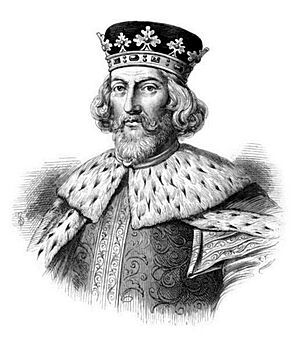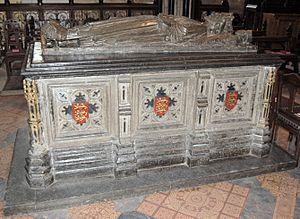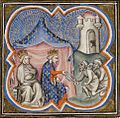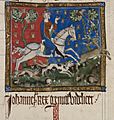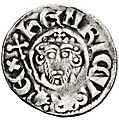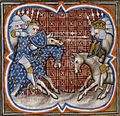John of England facts for kids
Quick facts for kids John |
|
|---|---|
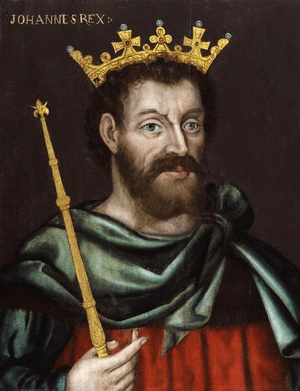
John of England
|
|
| King of England | |
| Reign | 27 May 1199 – 19 October 1216 |
| Coronation | 27 May 1199 |
| Predecessor | Richard I |
| Successor | Henry III |
| Lord of Ireland | |
| Reign | May 1177 – 19 October 1216 |
| Successor | Henry III |
| Born | 24 December 1166 Beaumont Palace, Oxford |
| Died | 19 October 1216 (aged 49) Newark Castle, Newark-on-Trent, Nottinghamshire |
| Burial | Worcester Cathedral |
| Spouse |
|
| House | Plantagenet/Angevin |
| Father | Henry II, King of England |
| Mother | Eleanor, Duchess of Aquitaine |
King John (born December 24, 1166 – died October 19, 1216) was the son of Henry II of England and Eleanor of Aquitaine. He became King of England on April 6, 1199, after his brother Richard I (also known as Richard the Lionheart) died.
His time as king was known for arguments with his powerful nobles (called barons) and church leaders (bishops). These arguments led to the nobles forcing him to sign an important agreement called the Magna Carta. The Magna Carta was a big step in English law. It was like the first "bill of rights" for England. It said that even kings had to follow certain laws and that nobles should have more say in how the country was run. This document not only changed English government but also inspired other countries' governments. John's reign was important, but many historians don't see it as very successful. He tried many times to get back lands in France that England had lost, but he never managed to.
Contents
John's Early Life and Family
As the fourth son of Henry II, John did not expect to inherit much land. Before John was born, Henry II had already divided his lands among his older sons. Later, there was a plan for John to receive Ireland as his own kingdom. However, his older brothers strongly disagreed with this idea.
When his father, Henry, died, John's brother Richard received all of Henry's possessions. John then accepted Ireland as a feudal holding from Richard. His family life was often difficult. His older brothers frequently rebelled against their father, Henry. His mother, Eleanor, was even imprisoned by Henry in 1173, when John was only about five years old.
Even as a young man, John had a reputation for being untrustworthy. He sometimes plotted with, and sometimes against, his elder brothers: Henry, Richard, and Geoffrey. In 1184, John and Richard both claimed they should inherit Aquitaine, which was one of many disagreements between them.
Richard's Absence and John's Actions
Richard, who was now King Richard I of England, was away on the Third Crusade from 1190 to 1194. During this time, John tried to take power from William Longchamp, the Bishop of Ely. Longchamp was Richard's chosen 'chief justiciar,' which was like a Regent or Prime Minister. This event helped create the idea of John as a villain in the legend of Robin Hood.
John was more popular than Longchamp in London. In October 1191, the city's leaders let John into the city while Longchamp was held in the Tower of London. John promised London the right to govern itself. In return, the city recognized him as Richard's likely heir.
On his way back from the Crusade, Richard was captured by Leopold V, Duke of Austria. Leopold then handed Richard over to Henry VI, the Holy Roman Emperor, who held him for ransom. Meanwhile, John had joined forces with Philip Augustus, King of France. They even sent a letter to Henry, asking him to keep Richard imprisoned for as long as possible. They offered money to make this happen. Henry refused their offer. Richard was set free after his mother, Eleanor of Aquitaine, paid the ransom. She even had to pawn the Crown Jewels to do so. John then asked Richard for forgiveness, which Richard granted. Richard even named John his heir.
John Becomes King
Becoming King of England
After Richard's death on April 6, 1199, John was accepted as king in Normandy and England. He was crowned king at Westminster on May 27, which was Ascension Day.
However, some regions in France, like Anjou, Maine, and Brittany, supported Arthur of Brittany. Arthur was the son of John's older brother, Geoffrey. Arthur fought his uncle John for the throne, with help from Philip II of France. This conflict had serious results for both of them. Eventually, Philip recognized John as king over Arthur. The price for this was John agreeing to be Philip's vassal (a ruler who owes loyalty to a more powerful king) in Normandy and Angevin.
Despite this agreement, conflicts continued. In 1202, Philip declared that all of John's French lands and territories, except Gascony in the southwest, now belonged to France. Philip immediately took control of them. Philip then gave Arthur all the land he had taken from John, except for Normandy. He also arranged for Arthur to marry his daughter, Marie.
John now needed to fight to get back 'his' land in France. In 1203, John ordered all shipyards in England to build at least one ship. The newly-built Portsmouth Naval Base was told to build several. He made Portsmouth the new main base for the navy. By the end of 1204, John had 45 large ships ready. From then on, an average of four new ships were built every year. He also created an Admiralty of four admirals, who were in charge of different parts of the new navy. During John's reign, ships were greatly improved. He also created the first large transport ships. Because of these efforts, John is sometimes given credit for starting the modern Royal Navy.
As part of the war, Arthur tried to capture his own grandmother, Eleanor of Aquitaine, at Mirebeau. But John's forces defeated and captured Arthur. Arthur was imprisoned first at Falaise and then at Rouen. After this, Arthur's exact fate is unknown, but many believe John had him killed. If he was murdered, Brittany and later Normandy rebelled against John. John also imprisoned his niece, Eleanor. Actions like these gave John a reputation for being very harsh.
Deals with French Cities
In 1203, John removed the "Grande Coutume" tax for the citizens and merchants of Bordeaux. This was the main tax on their exports. In return, the regions of Bordeaux, Bayonne, and Dax promised to support him against the French king. The open ports meant that merchants from Gascony could easily sell their wine in England for the first time. The next year, John gave the same tax breaks to La Rochelle and Poitou.
Losing Lands and Facing Disputes
Normandy Falls to France
In June 1204, the city of Rouen fell, allowing Philip to take over Normandy. He also took parts of Anjou and Poitou.
John needed money for his army, but losing the French territories, especially Normandy, greatly reduced the kingdom's income. A very large tax would be needed to try and get these lands back. He put in place the first income tax, which raised a huge sum of £70,000 at that time.
Disagreement with the Pope
When Archbishop of Canterbury Hubert Walter died on July 13, 1205, John got into a big argument with Pope Innocent III. The Canterbury Cathedral Chapter (a group of clergy) said they alone had the right to choose Hubert's replacement. They wanted Reginald, one of their own members. However, both the English bishops and the King wanted someone else for this powerful job. The king wanted John de Gray, one of his own men.
When their disagreement could not be solved, the Chapter secretly elected one of their members as Archbishop. A second election, forced by John, resulted in another choice. When both candidates went to the Vatican, Pope Innocent rejected both elections. He chose his own candidate, Stephen Langton, even though John's observers objected. John was supported by his English barons and many English bishops, and he refused to accept Langton.
John expelled the Canterbury Chapter in July 1207. The Pope reacted by placing an interdict on the kingdom. This meant that no one in England could receive religious blessings. John fought back by closing down the churches. He officially took control of all church possessions. However, individual churches could negotiate to manage their own properties and keep their income. After John was excommunicated, he made these rules even stricter. He gained a lot of money from the income of empty bishoprics and abbeys. For example, the church lost about 100,000 marks to the Crown in 1213. The Pope later allowed some churches to hold Mass behind closed doors in 1209. In 1212, they allowed last rites for the dying. While the interdict was hard for many, it did not cause a rebellion against John.
Excommunication and Submission
In November 1209, John was excommunicated (kicked out of the Church). In February 1213, Innocent threatened even stronger actions unless John gave in. John accepted the Pope's terms for giving in. This happened in May 1213, in front of the papal legate (the Pope's representative) Pandulph. John also offered to give the Kingdom of England to God and the Saints Peter and Paul. In return, he would pay a yearly feudal service of 1,000 marks (700 for England and 300 for Ireland). By doing this, John gained the support of his papal overlord in his new argument with the English barons.
After settling his dispute with the Pope, John focused again on France. The wars in Europe ended with a defeat at the Battle of Bouvines in July 1214. This forced the king to accept a bad peace deal with France.
Rebellion and Magna Carta
The Great Charter
The heavy tax (called scutage) for the failed war in France was the final straw. When John tried to raise more money in September 1214, many barons refused to pay. The barons no longer believed that John could get back the lands he had lost.
In May 1215, Robert Fitz Walter led forty barons to declare they would no longer be loyal to the king at Northampton. Their group, called the 'Army of God,' marched on London. They took control of the capital, as well as Lincoln and Exeter.
John met their leaders and their French and Scottish allies at Runnymede, near London, on June 15, 1215. There, they officially agreed to the Great Charter, known in Latin as Magna Carta. This document set up a council of 25 barons. Their job was to make sure John followed the rules, such as protecting people from illegal imprisonment, giving access to quick justice, requiring Parliament's approval for taxes, and limiting scutage.
Because he was forced to sign the charter, John asked his overlord, the Pope, for permission to break it. The Pope agreed, calling it "not only shameful and demeaning but also illegal and unjust." This led to the First Barons' War. The barons invited Prince Louis VIII of France to invade England. Louis accepted, hoping to become King of England himself.
War with the Barons
John traveled around the country to fight the rebel forces. He led a two-month siege of the rebel-held Rochester Castle. While a small force arrived in rebel-held London in November, the Scots, led by their king, Alexander II, invaded northern England. By the end of December, John was leading a harsh campaign in the north, which included sacking the town of Berwick-upon-Tweed.
The French retook Rochester and much of the south. However, John's royalist forces held onto Windsor and Dover.
As John's power weakened, some of his generals, including his half-brother William Longespée, joined the rebel side. By the end of the summer, Louis controlled a third of the country and had the support of two-thirds of the barons. In September, Alexander II traveled south to show his loyalty to Louis at Dover. The French prince had been besieging Dover Castle there.
John's Death
While retreating from the French invasion, John took a safe route around the marshy area of The Wash. This was to avoid the rebel-held area of East Anglia. However, his slow baggage train, which included the Crown Jewels, took a direct route across the marsh. It was lost to the incoming tide. This was a terrible blow to John, affecting his health and state of mind. He became ill with dysentery and moved from place to place. He died at Newark Castle on October 19, 1216. He was buried at Worcester Cathedral, in the West Midlands.
When King John died, his nine-year-old son, Henry, was too young to rule. William Marshal was chosen as Regent for Henry III. He would make decisions for Henry until he was old enough to rule. The barons then switched their loyalty to the new young king. This forced Louis to give up his claim to the throne and sign the Treaty of Lambeth in 1217.
John's Legacy
King John's reign started with military losses. He lost Normandy to Philip II of France in his first five years as king. His reign ended with England in a civil war, and he was almost forced out of power. In 1213, he made England a papal fief (a territory controlled by the Pope) to end a conflict with the Catholic Church. His rebellious barons forced him to sign the Magna Carta in 1215. This is the act for which he is most remembered.
John is also responsible for another famous English landmark: the historic, medieval London Bridge. To pay for building a large bridge across the Thames River, King John allowed houses, shops, and a church to be built on top of the bridge.
John was an effective ruler in many ways. However, he lost the support of the barons by taxing them in ways that were not traditional for feudal lords. The tax known as scutage became especially unpopular. John was also considered a fair and well-informed king. He often served as a judge in the Royal Courts, and people sought his justice. Also, John's use of a skilled Chancellor and clerks led to the first proper set of royal records.
Historian Winston Churchill once said that the British nation and English-speaking world owe more to John's flaws than to the good deeds of other kings. Medieval historian C. Warren Hollister described John as a puzzling figure. He was talented in some ways and good at managing details, but he was also suspicious, dishonest, and not trusted.
Marriage and Children
In 1189, John married Isabel of Gloucester. They did not have any children. John had their marriage annulled. She was never recognized as queen. John remarried on August 24, 1200, to Isabella of Angoulême. She was twenty years younger than him. John had taken her from her fiancé, Hugh X of Lusignan.
Isabella had five children with John:
- Henry III (1207–1272), who became King of England.
- Richard (1209–1272), 1st Earl of Cornwall.
- Joan (1210–1238), who became Queen Consort of Alexander II of Scotland.
- Isabella (1214–1241), who married Frederick II, Holy Roman Emperor.
- Eleanor (1215–1275), who married William Marshal, 2nd Earl of Pembroke, and later married Simon de Montfort, 6th Earl of Leicester.
John also had many other children outside of his marriages. Some of them include:
- Joan, who married Llywelyn the Great.
- Richard Fitz Roy, (by his cousin, Adela)
- Oliver FitzRoy, (by Hawise) who went on a Crusade in 1218 and did not return.
- Geoffrey FitzRoy, who died on an expedition to Poitou in 1205.
- John FitzRoy, a clerk in 1201.
- Henry FitzRoy, who died in 1245.
- Osbert Gifford, who was given lands in Oxfordshire, Norfolk, Suffolk, and Sussex.
- Eudes FitzRoy, who went on Crusade with his half-brother Richard and died in the Holy Land in 1241.
- Bartholomew FitzRoy, a member of a religious order.
- Maud FitzRoy, who was an Abbess (head of a convent) and died in 1252.
- Isabel FitzRoy, wife of Richard Fitz Ives.
- Philip FitzRoy, who was still alive in 1263.
The surname Fitzroy means 'son of the king' in Norman-French.
King John in Stories
John is also famous for his role in the Robin Hood stories, where he is one of Robin's enemies. Popular stories suggest that many people disliked him. However, we do not truly know what ordinary people thought in the 13th century. William Shakespeare wrote a play about him. This play was mostly about Arthur of Brittany and did not mention Robin Hood or Magna Carta.
Images for kids
-
Richard I (left) and Philip II Augustus at Acre during the Third Crusade
-
The effigy of Isabella of Angoulême, John's second wife, in Fontevraud Abbey in France
-
Phillip II's successful invasion of Normandy in 1204; blue arrows show the movement of Philip II's forces and light blue shows Philip's Breton allies
-
A pipe roll, part of the growing system of royal government around the year 1200
-
King John presenting a church, painted around 1250–1259 by Matthew Paris in his Historia Anglorum
-
An early-13th-century drawing by Matthew Paris showing warfare of the time, including castles, crossbowmen and mounted knights
-
A 13th-century drawing of John with two hunting dogs
-
Rochester Castle, an important fortress in the last years of John's reign
-
The French victory at the battle of Bouvines ruined John's plan to retake Normandy in 1214 and led to the First Barons' War.
-
An original version of Magna Carta, agreed by John and the barons in 1215
-
Self-portrait of Matthew Paris, one of the first historians of John's reign
-
John Foxe's Book of Martyrs, which had a positive view of John's reign
-
Shakespeare's play The Life and Death of King John
See Also
 In Spanish: Juan I de Inglaterra para niños
In Spanish: Juan I de Inglaterra para niños


